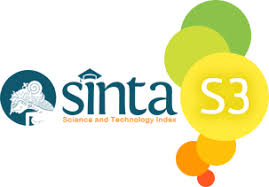Analisa prakmatik pelanggaran maksim percakapan dalam iklan mie sedaap: sebagai proses kreatif pembuatan iklan
 Abstract views: 883
,
Abstract views: 883
,
 PDF downloads: 1337
PDF downloads: 1337
Abstract
This study concerns with flouting the conversational maxim as a creative process in making advertisement. The objective of this study is to know how the conversational maxim are flouted to produce a creative advertisements. The writer formulates the following statements: (1) What kinds of conversational maxims are flouted in the source of data? (2) How do the copywriters flout the maxims? (3) What creative process come out as the result? The writer applies the pragmatics theory to find the addresser and addressee, the context of the utterances, the goals of the utterances, and the act of the utterances. She applies the theory of conversational maxim proposed by H. P. Grice, the theory of communication and advertisements. From the study, she finds out that the copywriters flout the maxim of quality by giving wrong or illogical statement; the maxim of manner by giving ambiguous statement; the maxim of relevance by giving irrelevant response; and maxim of quantity by giving too much information. There are 12 kinds of creative process namely: to attract consumers, to create humorous effect, to incite imagination and curiosity, building image, to persuade people, to influence emotion, building the setting, delivering moral, efficiency in language use and the co-text support the message.
References
Baskoro, A. P. (2018). Gaya Eksekusi Iklan Digital Studio Workshop Depok Melalui Poster. J-Ika. https://doi.org/10.31294/KOM.V5I1.2661
Bogdan, R., & Biklen, S. (1997). Qualitative research for education. Allyn & Bacon Boston, MA.
Fitria, Y., & Farida, F. (2018). Strategi Promosi Agen Properti Independen Pada Media Online. Jurnal Komunikasi Profesional. https://doi.org/10.25139/jkp.v2i2.1376
Huda, J. M., Prasetyo, I. J., & Fitriyah, I. (2019). Komunikasi Interpersonal Antar ODHA untuk Menumbuhkan Motivasi Kembali Hidup Normal di Yayasan Mahameru Surabaya. Jurnal Komunikasi Profesional. https://doi.org/10.25139/jkp.v3i1.1700
Istiqomah, Hidayat, Z., & Jariah, A. (2019). Analisis Pengaruh Kepercayaan , Iklan dan Persepsi Resiko Terhadap Keputusan Pembelian di situs Shopee di Kota Lumajang. Jurnal Progress Conference.
Leech, G. (2016). Principles of pragmatics. Routledge.
McCormick, K. (2016). Celebrity endorsements: Influence of a product-endorser match on Millennials attitudes and purchase intentions. Journal of Retailing and Consumer Services. https://doi.org/10.1016/j.jretconser.2016.05.012
Moriarty, S. (1991). Creative advertising: Theory and practice. Prentice Hall.
Muhammad, A. M., Prawiradiredja, S., & Fitriyah, I. (2018). Corporate Value: Persona pada Company Profile PT. Kereta Api Indonesia. Jurnal Komunikasi Profesional. https://doi.org/10.25139/jkp.v2i1.843
Nirmala, V. (2015). Tindak Tutur Ilokusi pada Iklan Komersial Sumatera Ekspress. Kandai. https://doi.org/10.12345/JK.V11I2.222
Panuju, R. (2017). Pengawasan Iklan Pelayanan Kesehatan Tradisional di Televisi. Jurnal Studi Komunikasi. https://doi.org/10.25139/jsk.v1i2.154
Pertiwi, A., Jusnita, R. A. E., & Maela, N. F. S. (2019). Ramadan dan Promosional: Strategi Komunikasi Pemasaran PT Unilever Indonesia Tbk. Jurnal Komunikasi Profesional. https://doi.org/10.25139/jkp.v3i1.1699
Rafa’al, M. (2017). Gaya Komunikasi Pemasaran di Pemerintah: Promotion Mix Destinasi Tujuan Wisata Kabupaten Raja Ampat. Jurnal Studi Komunikasi. https://doi.org/10.25139/jsk.v1i1.63
Renkema, J. (2004). Introduction to discourse studies. John Benjamins Publishing.
Rosalia Dwi Putri Loven , Maylanny Christin, A. I. (2016). Crisis Management Strategy Public Relations of Pt Kai Commuter. E-Proceeding of Management, 3(2), 2234–2249.
Sheldon, P., & Bryant, K. (2016). Instagram: Motives for its use and relationship to narcissism and contextual age. Computers in Human Behavior. https://doi.org/10.1016/j.chb.2015.12.059
Yule, G. (1996). Pragmatics: Oxford University Press. Oxford.
Copyright (c) 2020 Jurnal Komunikasi Profesional

This work is licensed under a Creative Commons Attribution-ShareAlike 4.0 International License.

Jurnal Komunikasi Profesional is licensed under a Creative Commons Attribution-ShareAlike 4.0 International License.
1. Proposed Policy for Journals That Offer Open Access
Authors who publish with this journal agree to the following terms:
- Authors retain copyright and grant the journal right of first publication with the work simultaneously licensed under a Creative Commons Attribution License that allows others to share the work with an acknowledgment of the work's authorship and initial publication in this journal.
- Authors are able to enter into separate, additional contractual arrangements for the non-exclusive distribution of the journal's published version of the work (e.g., post it to an institutional repository or publish it in a book), with an acknowledgement of its initial publication in this journal.
- Authors are permitted and encouraged to post their work online (e.g., in institutional repositories or on their website) prior to and during the submission process, as it can lead to productive exchanges, as well as earlier and greater citation of published work (See The Effect of Open Access).
2. Proposed Policy for Journals That Offer Delayed Open Access
Authors who publish with this journal agree to the following terms:
- Authors retain copyright and grant the journal right of first publication, with the work [SPECIFY PERIOD OF TIME] after publication simultaneously licensed under a Creative Commons Attribution License that allows others to share the work with an acknowledgement of the work's authorship and initial publication in this journal.
- Authors are able to enter into separate, additional contractual arrangements for the non-exclusive distribution of the journal's published version of the work (e.g., post it to an institutional repository or publish it in a book), with an acknowledgement of its initial publication in this journal.
- Authors are permitted and encouraged to post their work online (e.g., in institutional repositories or on their website) prior to and during the submission process, as it can lead to productive exchanges, as well as earlier and greater citation of published work (See The Effect of Open Access).



